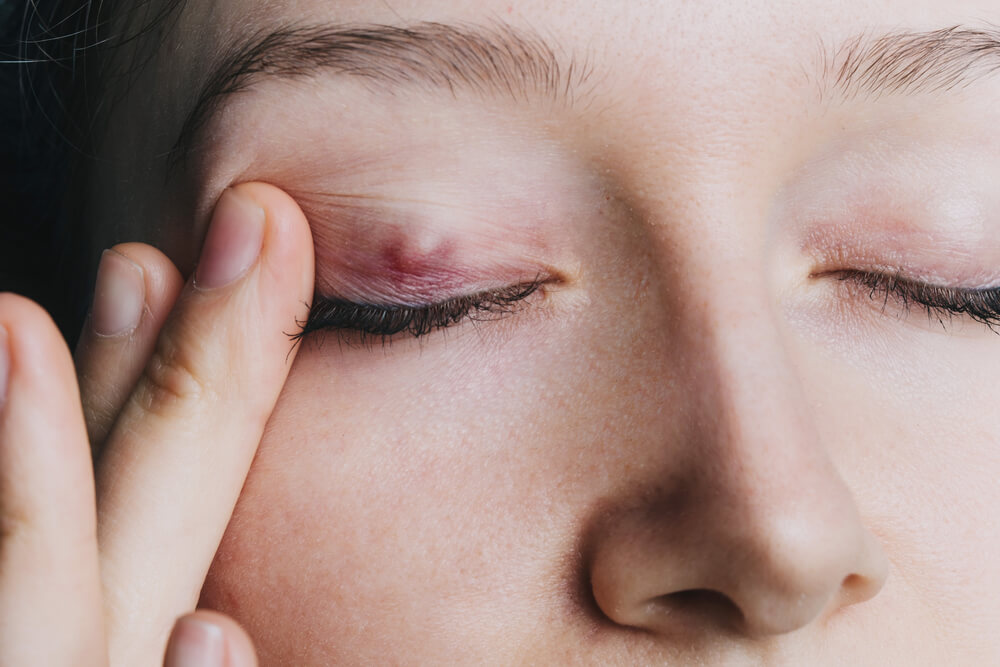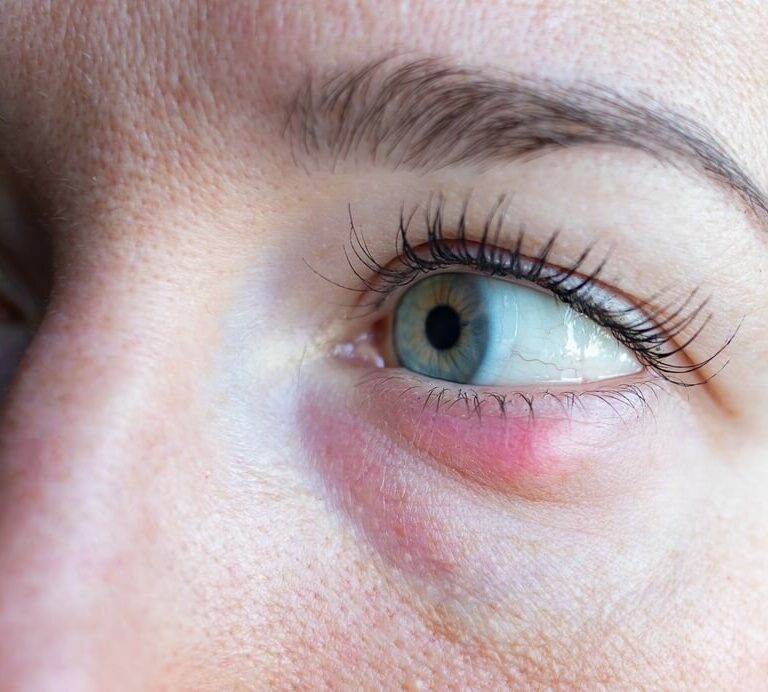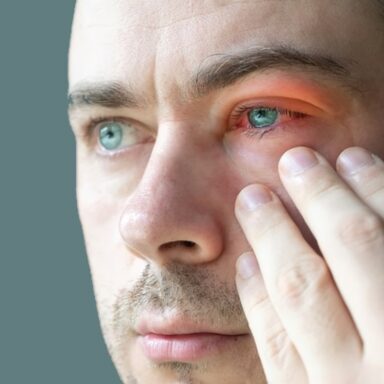If you’ve ever had a stye in your eye, you’ll know just how uncomfortable and annoying they can be. They don’t look great either but, thankfully, they usually clear up on their own. But they can also be very painful and, in some cases, they will keep popping up again and again and again.
If you do have a stye, there’s lots you can do to treat it at home and lots of little things you can do to prevent getting another one.
What is a stye and what causes them?
A stye is a small, red, painful lump that appears on your upper or lower eyelid. It can be filled with pus (yep, they are not very nice at all!) and have a small yellow spot at its tip.1
Most styes occur when the root of one of your eyelashes or a tiny oil gland on your eyelid gets infected with bacteria. These bugs normally live very happily, and harmlessly, on your body but, if they get trapped inside an oil gland or eyelash root, they can produce a painful pimple.2
There are two types of stye, or hordeolum (it’s pronounced haw-DEE-uh-luhm) as you’d call a stye, if you are being very proper.
External stye
These sit on the outer part of your upper or lower eyelid. They usually start in an eyelash root and are the most common type of stye.3
Internal stye
These are inside your eyelid (facing your eyeball – ouch!) and can push on your eye as they grow, making them more painful. They usually start in an oil gland.2
Did you know?
We have 75-80 lashes on our lower eyelids and 90-160 on our upper lids.4 Lashes are usually less than 1.2cm long – although the world record is a mascara-guzzling 20.5cm.5
What are the symptoms of a stye?
The signs and symptoms of a stye include:3
- A red, painful bump along the base of your eyelashes
- Swelling of the eyelid (sometimes the whole eyelid)
- A crust on the edge of your eyelid
- Scratchiness or feeling like something is in your eye
- Sensitivity to light
- A watery eye
- Red, bloodshot eyes
Who is at risk of styes?

Styes are very common – anyone can get them, at any age. But most are caused by bacteria, so you may up your risk if you:2,6
- Rub your eyes a lot – one to remember if hay fever or other allergies make your eyes itchy or if you often go without enough sleep.
- Skimp on taking off your eye make-up (or don’t take it off at all!) before going to bed.
- Use old make-up – go on, have a splurge!
- Forget to practise good contact lens hygiene.
Certain medical conditions also make you more likely to be troubled by styes. These include:3
- Blepharitis
- Dandruff
- Rosacea, a skin condition
- Diabetes
Plus, people who have had styes before are more likely to get them again.3
What is a chalazion?

There’s another type of eyelid bump called a chalazion – pronounced cha-LAY-zee-yon. A chalazion isn’t caused by a bacterial infection, like a stye, but by an oil gland that’s become clogged.3
Unlike a stye, it isn’t usually painful, although it can make your vision blurry if it grows big enough to press against your eyeball. Sometimes, it starts off as a stye before turning into a chalazion.3
It’s not always easy to tell a stye and a chalazion apart but, luckily, the treatments are similar.
Did you know?
If you have a chalazion, it will normally be on your upper eyelid. It is thought this is because the upper lid has twice as many tiny oil-producing glands as the lower lid – giving more scope for clogging.7 The oil made by these glands, the meibomian glands, coats the surface of the eye and stops our tears from drying out.
Symptoms of a stye vs a chalazion3
|
|
|
| Bump on eyelid | ✓ | ✓ |
| Very painful | ✓ | |
| Blurry vision | ✓ | |
| Pimple with a spot on its tip | ✓ | |
| Bump near edge of eyelid | ✓ | |
| Bump near middle of eyelid | ✓ | |
| Eyelid swelling | ✓ | ✓ |
| Scratchy feeling | ✓ | |
| Watery eyes | ✓ | ✓ |
| Firm rubbery lump | ✓ | |
| Crusty eyelid | ✓ | |
| Sensitivity to light | ✓ |
How to treat a stye
The main treatment for a stye or a chalazion involves giving your eyes some TLC. Dig out a clean flannel, soak it in warm water, wring it out a little, and hold it over the eye that is giving you bother for 10 to 15 minutes, three to five times a day.3 Keep the cloth nice and warm (and soothing) by soaking it every few minutes.
The warmth should help with any pain you are in. It should also help unclog any blocked oil glands and encourage a stye to come to a head, before it bursts and releases pus1 (a big step along the way to healing).
You can speed things along by using one of your fingers to gently massage the stye or chalazion through the washcloth.3 But take it easy and don’t squeeze – however tempting it is!
Top tip
Can’t find a flannel? Try a green tea bag instead. It may sound – and look – a bit odd but some eye experts think that a compress made of tea bags soaked in warm (not hot) water helps styes heal faster, thanks to green tea’s antibacterial powers.8

How to prevent a stye – and what to do when you feel one coming

There’s lots of simple things you can do to help keep styes away. Most of them involve good hand and facial hygiene. These include:2,9
- Washing your hands thoroughly – especially before touching your eyes.
- Trying not to rub your eyes. Medication can help ease the itchiness caused by hay fever and other allergies.
- Washing your hands before and after removing you contact lenses.
- Keeping your contacts clean and disinfected and not reusing disposable lenses.
- Removing your eye make-up before going to bed. This won’t just be good for your skin, it will help your eyes too.
- Throwing away your eye make-up every two to three months. (Expensive but also the chance to try a new look!)
If you have blepharitis, rosacea or another condition that raises your risk of styes, following your doctor’s instructions on how to manage it can help keep your styes under control, too.
Top tip
Baby shampoo may be mild, but it is a powerful weapon when it comes to preventing styes! If you get lots of styes, put a few drops of baby shampoo into a cup of warm water, stir and then use a flannel or cotton bud to gently brush the soapy mixture along the bottom of your eyelashes. Or simply rub a washcloth dipped in baby shampoo over your closed eyelids while you are in the shower.9
What to do when you feel a stye coming
A niggly, tender area near your eyelashes can be an early warning that a stye is on its way. Starting treatment straightaway, with a warm compress and a bit of gentle massage, can help you get rid of your stye more quickly.9
FAQs
How long do styes last?
Although styes can be painful, they are usually harmless and will go away on their own in a week or two.10 A chalazion can take longer to disappear – maybe a month or more.9 See the treatment section above for some tips on how to speed your stye on its way.
Why do I keep getting styes?
If it feels like you have just got rid of one stye, only for another to pop up, you may have blepharitis, rosacea or another condition that raises the risk of styes. Your doctor will be able to tell if you have an underlying health problem and how to treat it.9
Are styes caused by stress?
There’s no firm proof that stress causes styes but some eye doctors believe there is a link.11
Can a stye give you a headache?
Styes are not known to cause headaches. Normally, the pain or discomfort will be confined to or around your eye.12
Is it OK to pop a stye?
No! If you like squeezing spots, squeezing a stye until the gunk comes out may feel strangely satisfying but it could spread the infection to the rest of your eyelid.3
Are styes contagious?
Styes aren’t contagious – they don’t spread easily from person to person. But they can sometimes be spread through make-up or towels. So don’t share eye make-up with others and, when you have a stye, to be on the safe side, keep your towels separate from the ones your housemates are using.13
When to see a doctor

A stye will normally go away by itself and a chalazion will often vanish too. But you should seek help if your eyelid is so swollen that you can’t see, your eye is very painful or your vision has changed.1,13 Your doctor might prescribe antibiotics or give you a steroid jab.3
If your stye or chalazion is really stubborn and refuses to go away, you may need minor surgery. Your doctor will first use some local anaesthetic to numb your eyelid, then make a small cut in the bump and remove any gunk that is gathered inside it.3
Speak to your doctor, too, if your styes keep coming back over and over again.9




